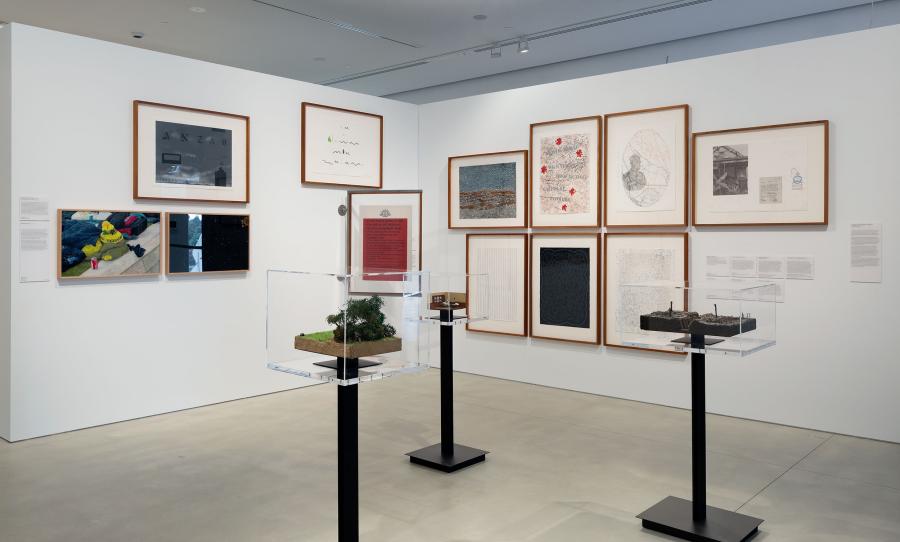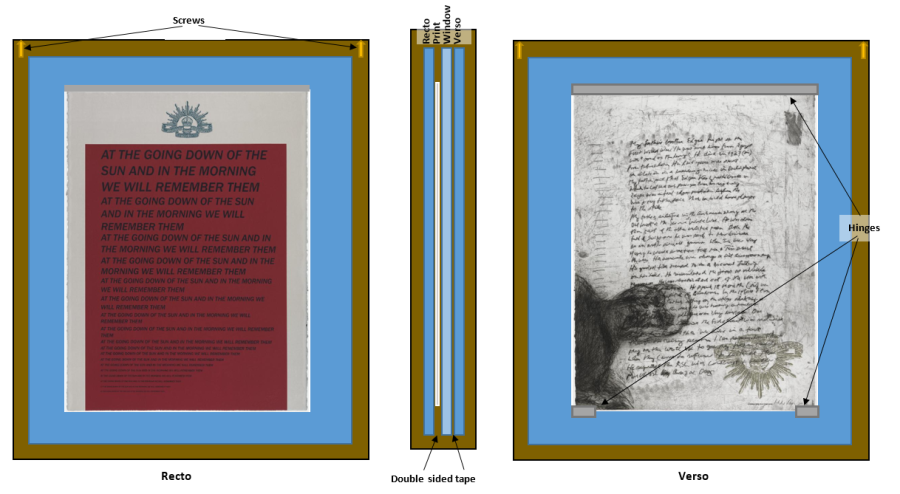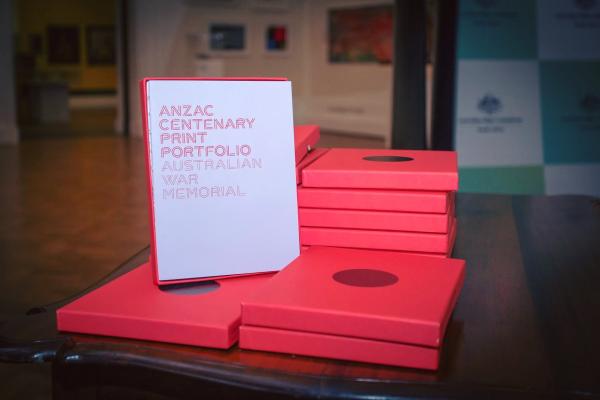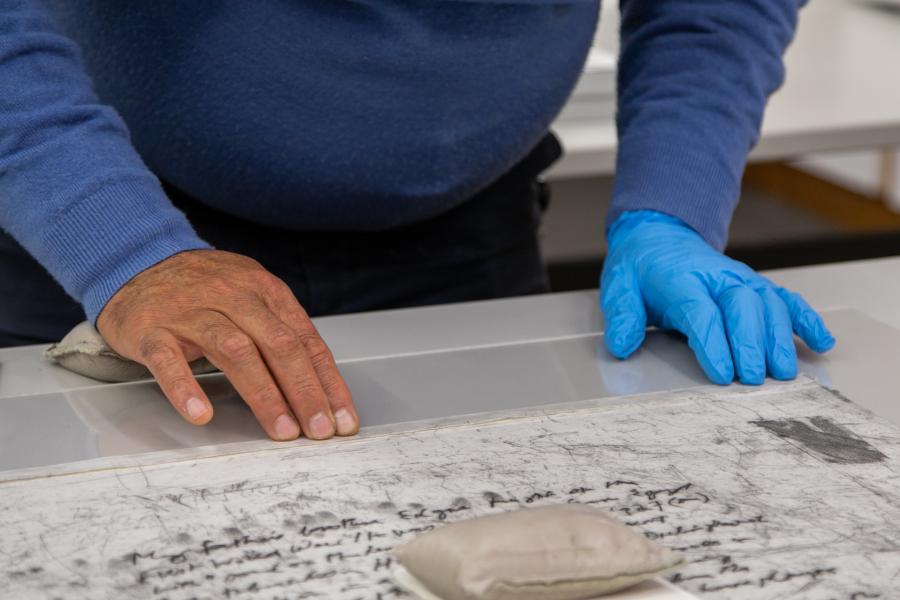Looking at both sides: the artwork of Mike Parr
Preparing a unique artwork for display in the Art in Conflict touring exhibition involved some fresh thinking.
Renowned for his provocative performance art and bold, often controversial ideas, Mike Parr is an undeniably prominent contemporary Australian artist.
Since cofounding the artist cooperative Inhibodress in the early 1970s with fellow artists Peter Kennedy and Tim Johnson, Parr’s performances – some depicting self-mutilation or extreme physical feats – have explored physical limits, questions of identity, memory and subjectivity.
A work for the Australian War Memorial, Invisible sun (the other side) reflects many of the same concerns, including a focus on self-portraiture and conceptual art.

Artist Mike Parr during the two-week residency at Megalo Print Studio, 2014. Each of the commissioned artists travelled to Canberra to produce their work.
Photographer: Kris Kerehona, PAIU2014/145.07
A flagship centenary project
In 2014, Parr was one of ten leading Australian and New Zealand artists commissioned by the Australian War Memorial to create an artistic response to the First World War.
The Anzac Centenary Print Portfolio (commonly known as “the Portfolio”) was a flagship project to explore the legacy of the Great War and the shared experience of our two nations, launched to coincide with the centenary of the First World War.
Each artist was to create a work of art using printmaking techniques, a medium which connects the past with the present, and pays tribute to Australia’s first official war artist, Will Dyson, who was a prolific printmaker.
Memorial Senior Curator of Art, Dr Anthea Gunn, says the Portfolio is a fascinating body of work.
“Incredibly diverse histories and experiences are represented, including family histories of some of the artists, one of which is Parr’s work,” Gunn said.
Anzac Centenary Print Portfolio
To mark the centenary the Australian War Memorial has commissioned the Anzac Centenary Print Portfolio, comprising contemporary artistic responses to the First World War by five Australian and five New Zealand artists.
Public and private memory
Parr was initially hesitant when invited to be part of the commission.
“I felt a bit apprehensive, only because I thought it’s something I’ve had strong opinions about, feelings about, thoughts about, for quite a lot of my life really,” Parr said.
“The military thing has never been something that I’d normally want to be associated with … because it wasn’t very well thought of in my family growing up.”
Parr’s uncle fought in the First World War, and his father served in New Guinea during the Second World War.
“[My father] regarded the RSL with contempt and wouldn’t march on Anzac Day.
“I thought it was entirely inappropriate for me to accept [the invitation] and then I thought, well maybe I’ve got to think about that.”
The result was Invisible sun (the other side). This double-sided print represents the different ways in which we remember war, the divisions between public and private memory, and the formal and the forgotten.
“War is a kind of psychotic breakdown of a culture … because it’s the moment of which there’s this enormous split. The community kind of coalesces and confronts the other and the other rapidly ceases to be something you can understand, they even cease to be human beings,” Parr said.
One side shows a bold red print, reminiscent of wartime ephemera, with a line from the Ode of Remembrance: “At the going down of the sun and in the morning we will remember them”. The phrase is repeated, decreasing in size until it evaporates from the page. Parr described the technique as a melancholic device, as well as a reflection on the passage of memory through generations.
On the other side of the artwork, a hand etched portrait offers a deeply personal account of war and violence carried by Parr’s family. His handwritten accounts of his father and uncle are scribbled into the artwork, highlighting the devastating and long-lasting effects of service.
“My father’s brother Edgar fought in the First World War. He was sent home from Egypt with “sand on the lungs,” the artwork states.
“His last years were spent in isolation in a boarding house in Darlinghurst.
“[He] was a first class cricketer before the War and my father said he could have played for the State.”

"My father enlisted in the Australian army at the outbreak of the Second World War. He was older than most of the other enlisted men."
Visit the collection page to read the full handwritten text.
Photographer: Alix Heraid, AWM24.PR.118
Art in Conflict
The Anzac Centenary Print Portfolio has been touring Australia since 2022 as part of the Art in Conflict exhibition, which showcases more than 70 diverse and contemporary responses to war from the National Collection of the Australian War Memorial.

Invisible sun (the other side) on display at Shepparton Art Museum in 2022. Courtesy Shepparton Art Museum. Photographer: Christian Capurro
“The portfolio was included in Art in Conflict as part of the theme ‘historic reflections’, which shows that an important part of our collection is how contemporary artists respond to historic events, often revealing aspects of it that otherwise haven’t been recorded in history, or aren’t well known,” said Dr Anthea Gunn.
Preparing the artwork to go on tour was no simple matter.
The double-sided nature of the print presented a challenge for conservators, who wanted to be able to display both sides to the audience.
Senior Paper Conservator Gajendra Rawat devised an alternative technique to hinge, matt and frame the work and allow it to be showcased.
“We didn’t want the artwork to be sandwiched between two sheets of Perspex (acrylic glass) as the paper used for printing has a matte surface. Instead, we created a technique where three sheets of Perspex were used for hinging and matting.”
“A special frame was designed with grooves on the side, where the whole package was slotted. This gave enough strength to the frame and also protected the artwork.”

The middle Perspex had a window cut to protect the work.
Touring Australia until 2026
Conservators will have the artwork ready to go back on tour for new audiences to view.
“Parr’s is one of my favourite works in the Portfolio,” Gunn said.
“It has really resonated with visitors to Art in Conflict; the way that on one side is a more messy personal history of the long intergenerational consequences of war on families, and the other shows the more official way that this is remembered or recognised in national commemorations. It really captures a lot of peoples’ experiences: of sharing in the communities’ sense of pride and honour, but also the lived reality of what trauma can mean day-to-day.”
Art in Conflict will open at the Glasshouse Port Macquarie on 9 November 2024.





